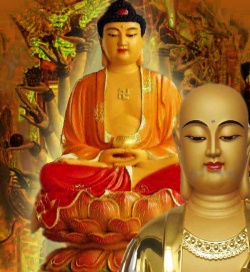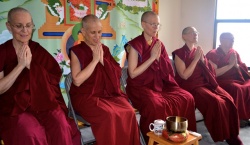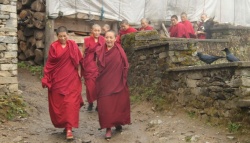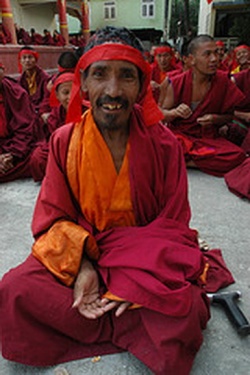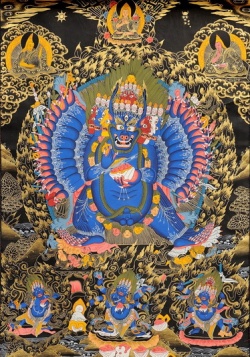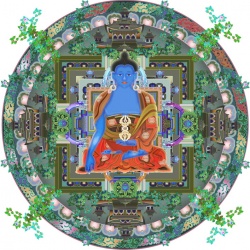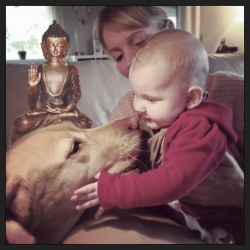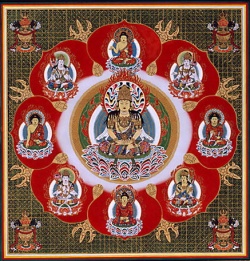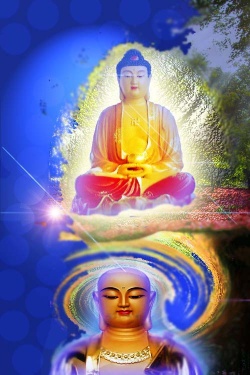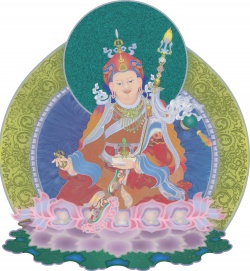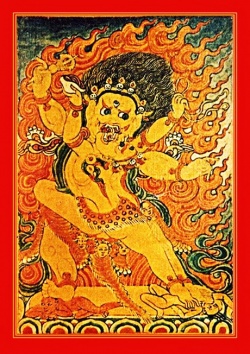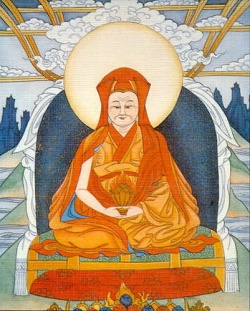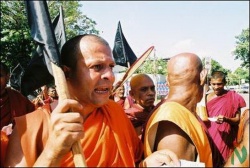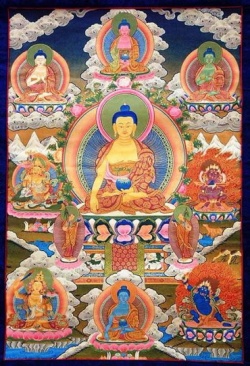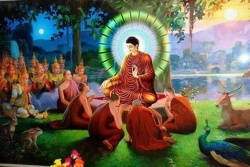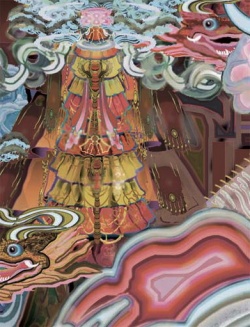Buddhism in America
Dalai Lama's Visit to Buffalo Gives Buddhism a Boost
by Joyce Kryszak, WBFO News Room, Sept 14, 2006
Buffalo, NY (USA) -- For some people, the pending visit from the Dalai Lama has sparked a fascination and perhaps even curiosity to learn more about the ancient religion of Buddhism. But for others in Western New York, Buddhism was a life commitment long before the visit from His Holiness.
Beneath the sanctuary of Westminster Presbyterian in Buffalo is a room you wouldn't expect to find in a church.
It's a Buddhist Zendo sanctuary.
Most of the time this is a modest room that looks like any other church meeting space. But not on Tuesdays. That's when the Buffalo Zen Dharma Group lights the incense and bows before the altar of Buddha.
It's the first Tuesday of the month when we make our visit. That means it's newcomers night. So, we're invited to join the regular members of the Group and five people who are here to explore Buddhism. Ray Ball is longtime, practicing Zen Buddhist and facilitator for the Buffalo group. He loves newcomers.
Ball said they only have about eight regular members in this Group. And it has been around for nearly a decade. There are a half dozen Buddhist Groups in the area of various traditions. Still, collectively it is estimated they only have about seventy-five members.
That's not too surprising really. This isn't an easy commitment.
Ball coaches the newcomers on how to safely sit zazen. That's the sometimes painful seated meditation that helps Buddhists to focus their breathing and thinking, so they can strive for complete mindfulness, called sati.
The roughly three-hour evening consists of a three, 25 minute each rounds of perfectly still meditation. That's interspersed with a series of chanted prayer and prostrations. Ball admits return visits from newcomers are rare.
But newcomer Tristan Goldberg is ready to dispel that theory. The Jewish-born, gentle-voiced young man says he's yearning for peace - no matter the personal cost.
For college student Ryan Trubits, the path to Buddhist discovery began many months ago, before all the excitement over the Dalai Lama's visit.
But he thinks the visit is raising awareness of Buddhism for others. Trubits would like the religion flourish. But he says the very nature of the tradition makes recruitment difficult.
And it won't be easy to simply spot a Buddhist to ask how you can join.
Jeanette Ludwig is a professor at UB and a ten-year member of the Buffalo Zen group. She comes each week dressed in a flowing gray robe and sits zazen on her own zafu meditation cushion.
But outside the zendo sanctuary - the graying, jewelry-clad woman looks like most anyone on the street. And she said you won't recognize a Buddhist by stereotypes either.
"Buddhists are, by no means, all calm and sweet all the time," said Ludwig. "They're people with emotions too." As a Buddhist and a teacher of religions Ludwig worries about the misperceptions and what she called the public portrayal of the religion that she called "Budddhism light."
That's why Ludwig has some concerns about the serioussness of some of the converts the Dalai Lama's visit might draw in.
Group facilitator Ray Ball agrees. He says Buddhism is filled with recovering Christians and Jews - or the curious and people looking for alternatives to psychotherapy.
The gray-robed senior student was himself brought up a strict Catholic. But he long ago devoted himself to Buddhism. He's even a member of the Zen Mountain Monastery in the Catskills. But he said to become a member there requires much more than curiosity or dues.
He said the training is rigorous and would-be students must be struggling with issues of life and death.
Fortunately, the admission price isn't quite so stiff for people interested in exploring a Buddhist practice locally. Ball said, at their Zen Group, all they ask is that you bring an open mind.
By Jane Lampman, Staff writer of The Christian Science Monitor
Thu Sep 14, 4:00 AM ET
CAMBRIDGE, MASS. - That genial face has become familiar across the globe - almost as recognizable when it comes to religious leaders, perhaps, as Pope John Paul II. When in America, the Dalai Lama is a sought-after speaker, sharing his compassionate message and engaging aura well beyond the Buddhist community.
After inaugurating a new Dalai Lama Center for Peace and Education in Vancouver, B.C., the Tibetan leader this week begins a visit to several US cities for public talks, sessions with young peacemakers, scientists, university faculty, corporate executives, and a California women's conference. But he'll also sit down for teach-ins among the burgeoning American faithful.
Buddhism is growing apace in the United States, and an identifiably American Buddhism is emerging. Teaching centers and sanghas (communities of people who practice together) are spreading here as American-born leaders reframe ancient principles in contemporary Western terms.
Though the religion born in India has been in the US since the 19th century, the number of adherents rose by 170 percent between 1990 and 2000, according to the American Religious Identity Survey. An ARIS estimate puts the total in 2004 at 1.5 million, while others have estimated twice that. "The 1.5 million is a low reasonable number," says Richard Seager, author of "Buddhism in America."
That makes Buddhism the country's fourth-largest religion, after Christianity, Judaism, and Islam. Immigrants from Asia probably account for two-thirds of the total, and converts about one-third, says Dr. Seager, a professor of religious studies at Hamilton College, in Clinton, N.Y.
What is drawing people (after that fascination with Zen Buddhism in the '50s and '60s)? The Dalai Lama himself has played a role, some say, and Buddhism's nonmissionizing approach fits well with Americans' search for meaningful spiritual paths.
"People feel that Buddhist figures like the Dalai Lama and Thich Nhat Hanh of Vietnam are contributing something, not trying to convert people," says Lama Surya Das, a highly trained American lama in the Tibetan tradition. "They are not building big temples, but offering wisdom and ways of reconciliation and peacemaking, which are so much needed."
Even a larger factor, he suggests, is that Buddhism offers spiritual practices that Western religions haven't emphasized.
"People are looking for experiential practices, not just a new belief system or a new set of ethical rules which we already have, and are much the same in all religions," Surya Das says. "It's the transformative practices like meditation which people are really attracted to."
At a sangha "sitting" in Cambridge, Mass., last week, some 20 devotees sat cross-legged on four rows of large burgundy-colored cushions before a small candlelit altar. A practice leader led a quiet hour of meditation interspersed with the chanting of prayers and mantras. The group then gathered in a circle for a half hour of discussion.
Carol Marsh, an architect who served as practice leader for the evening, had an interest in finding a spiritual path for years, but was "resistant to anything nonrationalist," she says afterward in an interview. "Then I read 'Awakening the Buddha Within,' (Surya Das's first book on 'Tibetan wisdom for the Western world'], and it spoke to me directly.... My ultimate aim is liberation."
After eight years of practicing, "I am happier, more grateful, more able to roll with whatever punches or moments of annoyance may present themselves," Ms. Marsh says.
What's so valuable to Jane Moss, who's been practicing 15 years, is learning how "to be in the present moment." And also to accept that reality involves perfection and "to view the world as good and people as basically loving." Each month, the group holds a meditation focused on love and compassion.
The sangha has been meeting since 1991, when Surya Das opened the Dzogchen Center here after decades of training with Tibetan teachers. Before becoming a lama, he was Jeffrey Miller, raised in a middle-class Jewish family in Brooklyn. An anti-Vietnam-War activist while at the University of Buffalo (N.Y.), he was stunned when his good friend Allison Krause was shot and killed by the National Guard at Kent State in 1970.
"When I graduated in 1972, I was disillusioned with radical politics - I realized fighting for peace was a contradiction in terms, and I wanted to find inner peace," he explains. Instead of graduate school, the young Miller headed off on a search that ended up in the Himalayas, where he spent the rest of the '70s and '80s learning from Buddhist teachers while teaching some of them English.
There were plenty of struggles and moments of doubt, but also illumination, he says. Following a centuries-old path to cultivate awareness, his training included two three-year retreats of intensely focused practice.
"One of the great lessons of that monastic brotherhood was learning to love even those people I didn't like," he says, speaking by phone from a retreat in Texas where he's training others.
There are many schools of Buddhism, but "everyone agrees that the purpose is the individual and collective realization of Enlightenment," Surya Das continues. "That is defined as nirvanic peace, wisdom, and selfless love. It involves a practice path that depends on meditation, ethical behavior, and developing insight and active love."
Buddha means "awakened" in Sanskrit, a language of ancient India, where Siddhartha Gautama founded the faith and an Eightfold Path some 2,500 years ago. Buddhists believe that through that path one awakens to what already is - "the natural great perfection." They do not speak of God, but of the human or ego mind with a small "m," and the Buddha (awakened) Mind with a big "m."
"Healing energy takes place through an agency far greater than, yet immanent in each of us," Surya Das has written. "We are all Buddhas."
One doesn't have to subscribe to a catechism or creed, or be a vegetarian. Nor do people have to give up their religion. That's why some Americans speak of being Jewish Buddhists, for instance.
The Dalai Lama, in fact, often encourages people to stay with the faith of their cultural upbringing, to avoid the confusion that can sometimes result from a mixing of Eastern and Western perspectives.
Yet others are going more fully into Buddhist study, particularly as the writings and training by American-born teachers increase its accessibility.
The Dzogchen Center (Dzogchen means "the innate great completeness"), which has sanghas in several states, teaches an advanced Tibetan practice; annually, it offers numerous retreats, from one-day to two-week gatherings. Surya Das - whose Tibetan teacher gave him his name, which means "follower or disciple of the light" - is the spiritual director.
Thirty devotees are currently cloistered in a 100-day retreat for advanced students at the Dzogchen retreat center outside Austin, Texas. They are in the third of a 12-year cycle of silent retreats - which will likely produce new teachers.
Several Tibetan teachers helped introduce Buddhism in the US, and one, Chogyam Trungpa, founded Naropa University in Boulder, Colo. But the teacher succumbed to excesses that tempt clergy of various faiths - alcoholism and sexual misconduct.
The Dalai Lama has warned, too, of some teachers who seek leadership for financial rather than spiritual reasons. The issue of students and teachers is today one of the most controversial in transmission of teaching from East to West, says Surya Das.
Still, a healthy American Buddhism with its own characteristics is emerging. It is less doctrinal and ritualistic than in the East and more meditation oriented, less hierarchical and more democratic and egalitarian. It is more lay-oriented than monastic, and more socially and ecologically engaged.
Perhaps most noticeably, "the role of women as leaders and teachers is very significant here," Seager says.
The Dalai Lama speaks of Buddhism naturally taking new forms in each culture. As he travels the globe, he also emphasizes building bridges between faiths, as well as finding nonviolent means for resolving differences. This weekend, the Nobel Peace Laureate will spend time with youths in Denver engaged in conflict-resolution projects. He'll bless the Great Stupa, the largest example of Buddhist sacred architecture in the US, located at Colorado's Shambhala Mountain Center.
Next week he'll speak to 20,000 at a football stadium in Buffalo, and at the alma mater of Surya Das, who was one of his attendants for several years. The American lama will also speak.
"Buddhism made me a mensch and brought me happiness," Surya Das concludes contentedly, "and helped me find my place in life and the universe
Buffalo, NY (USA) -- Dalai Lama mania hit the Buffalo area Tuesday, as thousands descended on the University at Buffalo North Campus in Amherst to hear a "simple monk" deliver a message about the power of human compassion.
Some audience members abandoned their stadium seats to gather at a giant video screen on the field for a closed-circuit take at Tuesday's address of the 14th Dalai Lama to a sold-out University at Buffalo Stadium.
It is, he said, essential for those searching for meaning and success in life.
"I think warmheartedness is the key," he said. "That gives you deeper satisfaction and more happiness."
Ultimately, hearts filled with "unbiased" compassion leave little room for hypocrisy, injustice and exploitation, leading to greater social change throughout the world, said the 1989 Nobel Peace Prize laureate.
"This century should be a century of dialogue," he said, "not a century of violence."
The crowd applauded.
The 14th Dalai Lama, Tenzin Gyatso, opened UB's Distinguished Speakers Series with a bang, addressing an estimated 30,000 in UB Stadium, considered the largest single event in the university's history.
The university canceled classes on the North Campus. Vendors sold beaded necklaces and Buddhism books. People took off from work, and their children skipped school. Security on campus was tight.
"What's going on here?" asked one woman, as a large crowd formed around an escort vehicle.
"We heard it's the Dalai Lama," responded another.
While the local Buddhist community is relatively small, the spiritual leader captivated Western New York enough to pack a football stadium and bring another 6,000 to fill Alumni Arena for an interfaith service Monday afternoon.
Besides UB students, staff and faculty, the visit by the exiled Tibetan leader also drew several thousand from across the border, the Rochester and Syracuse areas, and from as far away as the states of Washington and Florida, university officials said.
In a world filled with daily fears and anxieties, people were curious about this man filled with inner peace.
"I really don't know that much about Buddhism, but he's a world iconic figure and here he is in Buffalo," said Sharon Nisengard, 32, of Buffalo. "I would say his name brought me more than anything."
For those who came to hear him speak because they were curious about who he is, and what he had to say, that's OK, the Dalai Lama told the crowd.
But early on he warned those who came expecting to see him perform miracles and see healing powers.
"That," he said, "I think is nonsense."
"I'm nothing," he added. "Just one of you."
Instead, the Dalai Lama over and over again stressed "warmheartedness" as the theme of his address, "Promoting Peace Across Borders Through Education."
He appealed to educators to help students from kindergarten through college develop compassionate hearts.
And he stressed that theme in marital relationships, too.
"We need more patience, more reconciliation from both sides. Particularly those who have children," he said to couples. "Think more compassionately, at least toward your children."
The day began early.
Eager to beat traffic or drop in on any number of lectures being offered, curious spectators began arriving on campus by 9 a.m. Tuesday.
Some of the educational events surrounding the Dalai Lama's visit drew long lines, including a ceremony marking the deconstruction of a sand painting that Tibetan monks had created over the prior three days. A talk by Lama Surya Das, a UB alumnus who has studied with the Dalai Lama and is well-known among practitioners of Tibetan Buddhism in the West, was filled to capacity.
Some groups on campus had a more intimate encounter with the famous monk and his trademark good humor.
"I was curious to see what kind of aura and personality he has," said Thomas Szyperski, one of 300 faculty members who met with the Dalai Lama for about an hour in the morning. "He's a very calm person, a very friendly person, a lot of humor."
The Dalai Lama took about eight questions from the faculty, on a range of issues from "why are we on this earth?" to world overpopulation, said Szyperski.
"His replies were quite lengthy," the chemistry professor said.
A group of about 175 Asian students also met for an hour with the Tibetan leader.
"He's really special," said Chris Lee, a native of Taiwan and a graduate student in business. "He's not allowed to go to Taiwan now, so this is probably our only chance to see him."
The Dalai Lama was introduced by UB President John B. Simpson on stage at about 3 p.m., when he received an honorary doctorate in humane letters by State University of New York Chancellor John Ryan.
Wearing a red robe and visor to keep out the sun and wind, the Dalai Lama sat on stage with his translator at his side for those moments when he was looking for the right word. With state, local and university officials sitting behind him, the Dalai Lama spoke for more than an hour, before fielding questions submitted earlier.
During his speech, the Dalai Lama also addressed those who heard what he had to say and didn't like it.
"Then forget it," he cracked. "No problem."
If not for a few Tibetan prayer flags waving from the beet-red porch, Namgyal Monastery might look like any other old Victorian house on North Aurora Street.
Unlike the impossible-to-miss St. Pauls United Methodist Church two blocks away, Namgyal Monastery and Institute of Buddhist Studies blends right into its surroundings. But it is by no means hidden in Ithaca. The monastery, along with Tibetan Buddhist publisher Snow Lion Publications, makes Ithaca a thriving Buddhist community.
Namgyal is the Ithaca branch of the Dalai Lamas original monastery of the same name, still located in Dharmasala, India. That monastery was founded in the 16th century. The Ithaca branch, considered the North American seat of the Dalai Lama, is only 14 years old. Namgyal is an important center for prayer, said Babette Teich-Visco, a monastery board member, but its primary goal is to educate.
Our plan was to have a program set up here at the Institute of Buddhist studies, Teich-Visco said. That would prepare Westerners to then be able to go over to India and jump in and finish the course over there.
While Namgyal may not be preparing would-be monks to study in India today, the monastery still provides a variety of classes for those interested in Buddhism in Ithaca and the surrounding area. The monasterys classes attract people from as far as Syracuse. Courtney Love even traveled to Ithaca from Seattle to have her deceased husband Kurt Cobains ashes blessed by Namgyal monks.
We dont have the actual ashes anymore, Teich-Visco said. But every year on the anniversary of his death, we seem to get one or two curious people who stop by to see.
Practicing meditation in the monasterys living room-turned-shrine room is a peaceful experience. The old wooden walls have absorbed so much incense during the years that there is an almost permanent aroma, but Teich-Visco said she laments that space is increasingly becoming a problem.
There are teachers that we would love to invite that we just cant because were just too small, Teich-Visco said. There is just not enough room.
Namgyal recently broke ground on a new retreat center and monastery down the road from Ithaca College on Route 96-B. Even when the retreat center is completed, Teich-Visco said Namgyal would never abandon the place where it all started.
Namgyal is not the only Buddhist institution in downtown Ithaca. The monastery opened in Ithaca in part because of the towns small community of Tibetan refugees who had arrived here in the 1980s, and also because of a highly influential Tibetan Buddhist publishing company, based in Ithaca since the early 80s.
Snow Lion Publications was named after the mythological creature of the same name, which is a national symbol of Tibet. It came into being in 1980, shortly after the Dalai Lama made his first visit to the United States. Unlike other publications, Snow Lion does not ascribe to a specific Buddhist lineage. Jeff Cox, president of Snow Lion, said the newsletter tries to steer clear of politics and instead focuses on spreading Tibetan Buddhist teachings.
Were only political in the sense that we support the Dalai Lamas efforts to resolve the Tibetan issue, Cox said.
While it does release a quarterly newsletter on Tibetan Buddhism with a circulation of roughly 30,000, Cox said Snow Lion is primarily a publishing company.
There werent many books on Tibetan Buddhism available when we began because they have to be translated, Cox said, and pointed to a small set of wooden shelves on the wall. You could probably fit every book in English on Tibetan Buddhism on this case.
Snow Lion started out humbly, publishing three books a year at most until 1987, when a new investor came in and had the company print 10 books a year.
Since then, Snow Lion has only continued to grow, with 200 books in print, not to mention 400 or 500 other books from publishers worldwide.
Snow Lion Publications will release author Zach Larsons first book this month. Larson, who lives in New York City, was introduced to Buddhism when he was 16.
I practiced meditation for the first time in the mountains and really became enthralled with the Tibetan Buddhist philosophy, Larson said. I wanted to dedicate myself to learning the great teachings and eventually translating the teachings into English and learning from the great masters in the Himalayas.
At Ithaca College, Brian Karafin, assistant professor of philosophy and religion, has used readings from Snow Lion in his classes. Karafin initially came across Snow Lion about 20 years ago and considers it a valuable source of information on Tibet and Tibetan Buddhism.
Snow Lion basically has this mandate to be part of a kind of cultural preservation, to preserve Tibetan culture and religion, Karafin said.
Snow Lion Publications and the Namgyal Monastery are linked in their mutual goal of preserving Tibetan Buddhism. Teich-Visco said Snow Lion and Namgyal have a collaborative relationship.
Were an institute that teaches Buddhism, Teich-Visco said. Theyve got the resources that help.
"Religion is fragmenting the human community"
"Religious polarization is part of many world conflicts, he said, including those involving Israel and Iran, "but it's never discussed. I consider it the story of our time, what religion is doing to us. But there are very few people calling a spade a spade."
It is indeed sad that religions proclaiming to bring about peace and harmony has caused such untold suffering and bloodshed throughout human history, and is continuing to sow the seeds of disunity and conflicts even now.
This is one of the many reasons why I am a Buddhist. Indeed, Buddhism is beyond preaching and scaring people into conversion. Buddhism is beyond claiming that MY God is real and all others are not. Buddhism is beyond surrendering your individuality for the supplication and appeasement of a deity. Buddhism is beyond dividing fellow humans into believers and unbelievers. Buddhism is beyond dogma and faith.
In short, Buddhism is beyond religion.
